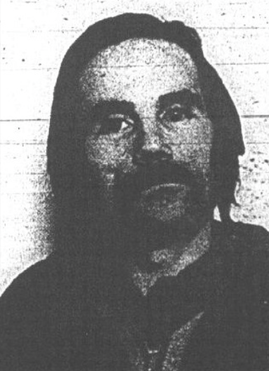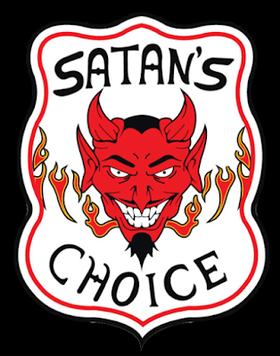Related Research Articles

Yves Trudeau, also known as "Apache" and "The Mad Bomber", was a Canadian outlaw biker, gangster and contract killer. A former member of the Hells Angels North chapter in Laval, Quebec, Trudeau was the club's leading assassin and a major participant in multiple biker conflicts throughout Canadian history, including the Popeyes–Devils Disciples War, the Satan's Choice–Popeyes War and the First Biker War. Frustrated by cocaine addiction and his suspicion that his fellow gang members wanted him dead, he became a Crown witness after the Lennoxville massacre. In exchange, he received a lenient sentence – life in prison but eligible for parole after seven years – for the killing of 43 people from September 1973 to July 1985.

Satan's Choice Motorcycle Club (SCMC) was a Canadian outlaw motorcycle club that was once the dominant outlaw club in Ontario, with twelve chapters based in the province, and another in Montreal, Quebec, at its peak strength in 1977. Satan's Choice grew to more than 400 members by 1970, making it the second largest outlaw motorcycle club in the world, behind only the Hells Angels.
Wolodumir "Walter" Stadnick, also known as "Nurget", is a Canadian outlaw biker and gangster who was the third national president of the Hells Angels Motorcycle Club in Canada. Stadnick is generally credited with turning the Hells Angels into the dominant outlaw biker club in Canada. The journalists Michel Auger and Peter Edwards wrote that much about Stadnick is mysterious, ranging from what is the meaning of his sobriquet "Nurget", to how a unilingual Anglo Canadian from Hamilton became the leader of the then largely French-Canadian Hells Angels. In 2004, the journalist Tu Thanh Ha wrote that Stadnick is "a secretive man little known to the public", but "he is one of Canada's most pivotal organized-crime figures."
Bernard Dieudonné Guindon, better known as "Bernie the Frog", is a Canadian former outlaw biker, gangster and boxer, best known as the founder and national president of Satan's Choice Motorcycle Club from 1965 to 2000. He was later a member of the Hells Angels until his retirement in 2006.
Francesco "Cisco" Lenti is a Canadian outlaw biker and gangster, best known as the co-founder of the Loners Motorcycle Club.

The Loners Motorcycle Club (LMC) is an international outlaw motorcycle club founded in Woodbridge, Ontario, Canada in 1979. It has seventeen chapters in Canada, eleven chapters in Italy, eleven in the United States. They also possess several chapters in other countries across the world. The club was established by two prominent Italian-Canadian bikers, Frank Lenti and Gennaro Raso.
Steven Gault is a Canadian outlaw biker and police informer who played a key role in the Ontario Provincial Police's (OPP) Project Tandem operation against the Hells Angels between 2005 and 2006.
The Satan's Choice–Popeyes War was the first major outlaw motorcycle club conflict in Canada's history, involving the country's two largest Motorcycle Clubs; the Satan's Choice from Ontario, and the Popeyes from Quebec. The conflict lasted from 1974 until 1976 and saw the two motorcycle clubs battle for dominance in the country. The conflict misleadingly known in Canada as the "First Biker War" would begin a year later in 1977.
From 1977 to 1984, the Hells Angels and the Outlaws Motorcycle Club fought what came to be known in Canada as the First Biker War. The Angels emerged victorious. As the Outlaws retreated into their Ontario stronghold, the Angels began consolidating their activities and expanding, moving into port cities Halifax, Nova Scotia and Vancouver, British Columbia. The conflict is known in Canada as the "First Biker War", but the first large conflict between bikers in Canada, was the Satan's Choice-Popeyes War which occurred from 1974 to 1976.
The Ontario Biker War in Canada saw the Hells Angels engage their long-term rivals the Outlaws Motorcycle Club for control of the province of Ontario. The war occurred between 1999 and 2002 and is also known as the London Biker conflict as a large majority of the events occurred in the city of London, Ontario. The Quebec Biker War, the largest motorcycle conflict in history was occurring during the same period in the province of Quebec.
Lorne Edgar Campbell is a Canadian former outlaw biker and gangster. One of the earliest members of the Satan's Choice Motorcycle Club, which he joined in 1965 at the age of 17, Campbell remained a life-long member of the club, staying on until Satan's Choice joined the Hells Angels in 2000. Campbell served as the president of Satan's Choice Oshawa chapter from 1985 to 1997, and of the Hells Angels' Sudbury chapter from 2001 to 2006, amassing a number of convictions.
Garnet Douglas McEwen, nicknamed "Mother", was a Canadian outlaw biker, gangster and police informer, most notable as a longtime member of Satan's Choice Motorcycle Club before serving as the first national president of the Outlaws Motorcycle Club in Canada.
Michel Alexandre Dubé was a Canadian outlaw biker and gangster. President of the Sudbury, Ontario chapter of the Satan's Choice Motorcycle Club, Dubé committed suicide in jail after being charged with two counts of first-degree murder and the bombing of a police station.
Gennaro Raso or Jimmy Raso is an Italian-Canadian outlaw biker, who is best known for co-founding the Loners Motorcycle Club with close friend Frank Lenti. He would end up retaining full leadership over the club in 1994 and currently serves as the club's International President.
Armand Sanguigni was a Canadian outlaw biker, gangster, and hitman for the Cotroni family who was one of the accused in the Port Hope 8 case.
Gordon John van Haarlem is a Canadian outlaw biker who was one of the "Port Hope 8" tried in one of the most controversial trials in Canadian history.
Howard Doyle Berry better known as "Pigpen" is a Canadian outlaw biker, criminal and gangster.
Terrance Levi Hall was a Canadian policeman who served as an officer of the Toronto Police Service and the Ontario Provincial Police (OPP). Hall was the commander of the OPP's Special Squad, which targeted outlaw biker gangs, and was the lead investigator in the Port Hope 8 case, in which six members of Satan's Choice Motorcycle Club were controversially convicted of murder.
Harold Paul Barnes, better known as "Johnny Sombrero", was a Canadian outlaw biker and gangster who was the founder and leader of the Black Diamond Riders Motorcycle Club of Toronto.
References
- ↑ Edwards 2017, p. 23.
- 1 2 3 Edwards 2017, p. 24.
- ↑ Lowe 2013, p. 67.
- 1 2 Melcher 2018, p. 370.
- 1 2 Edwards 2013, p. 17.
- ↑ Lowe 2013, p. 69.
- ↑ Edwards 2017, p. 26.
- ↑ Lewis, Michael (12 November 2016). "The legend of late Toronto biker Johnny Sombrero lives on". The Toronto Star. Retrieved 5 July 2024.
- 1 2 Melcher 2018, p. 370-371.
- ↑ Melcher 2018, p. 371.
- ↑ Edwards 2017, p. 50.
- ↑ Edwards 2017, p. 112.
- ↑ Edwards 2017, p. 129.
- ↑ Edwards 2017, p. 210.
- 1 2 3 Edwards 2017, p. 211.
- 1 2 3 Lavigne 1999, p. 214.
- ↑ Langton 2006, p. 150.
- 1 2 Langton 2006, p. 151.
- ↑ Edwards 2017, p. 269.